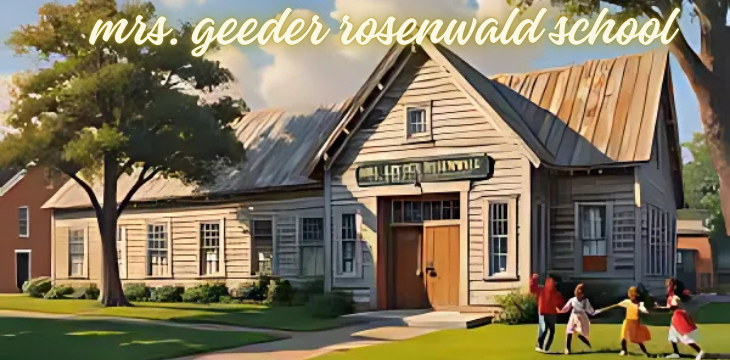When you think about education’s role in shaping communities, certain institutions stand out as beacons of change. One such remarkable example is the Mrs. Geeder Rosenwald School. But what makes it so special? Why does its story still resonate today? Well, hold onto your hats, because this isn’t just another tale about bricks and mortar. This is about resilience, hope, and a commitment to a brighter future.
The Rosenwald Schools were part of an ambitious effort to uplift African American communities in the South during a time when education wasn’t a privilege for everyone. The Mrs. Geeder Rosenwald School was one of those jewels, and its impact still ripples through history. Let’s take a closer look at this hidden gem and uncover its fascinating story.
The Birth of a Vision mrs. geeder rosenwald school
Who Was Julius Rosenwald?
Before diving into the specifics of the Mrs. Geeder Rosenwald School, let’s talk about the man behind the movement—Julius Rosenwald. As the president of Sears, Roebuck & Co., Rosenwald was more than just a successful businessman. He was a philanthropist with a dream: to bridge the educational gap in the segregated South.
Rosenwald partnered with Booker T. Washington of the Tuskegee Institute to fund the construction of schools for African American children. These institutions weren’t just schools; they were sanctuaries of learning and equality.
How Did Mrs. Geeder Fit In?
Mrs. Geeder, a local advocate for education, spearheaded efforts to bring a Rosenwald School to her community. With tireless determination and a knack for rallying support, she made it happen. The school became a symbol of her unwavering belief in the power of education.
The Architecture of Dreams mrs. geeder rosenwald school
Why Were Rosenwald Schools So Unique?
The Mrs. Geeder Rosenwald School, like others in the program, followed a meticulous architectural plan. These weren’t just thrown-together buildings! They were designed with care to maximize natural light, promote ventilation, and create an inviting learning environment.
Key features included:
- Large windows to brighten classrooms.
- Movable partitions to create flexible learning spaces.
- Durable, low-cost materials to stretch funding.
A Community Effort
Here’s the kicker—these schools weren’t just funded by Rosenwald’s foundation. Local communities contributed money, labor, and resources. Mrs. Geeder herself organized fundraising events, from bake sales to church donations, proving that when people work together, amazing things happen.
The Role of the mrs. geeder rosenwald school
in Its Time
A Haven for Education
During an era when African American students faced systemic obstacles, the Mrs. Geeder Rosenwald School’S offered something rare: opportunity. It was a place where children could learn to read, write, and dream beyond the confines of their circumstances.
Empowering Teachers
Let’s not forget the unsung heroes—the teachers! Often underpaid but incredibly dedicated, they nurtured generations of students, instilling not just knowledge but also pride and self-worth.
Challenges Along the Way
The Struggles of Segregation mrs. geeder rosenwald school
Operating within a segregated system wasn’t easy. Funding was limited, and supplies were often second-hand. But the spirit of the school community was unbreakable. They turned challenges into opportunities, showing the world what determination looks like.
The Fight to Preserve
As times changed and integration began, many Rosenwald Schools, including the Mrs. Geeder Rosenwald School’S, faced closure. But alumni and community members refused to let its legacy fade, rallying to preserve its history.
The Legacy Lives On mrs. geeder rosenwald school
What Happened to the Mrs. Geeder Rosenwald School?
While the school no longer operates as an educational institution, it stands as a historical landmark. Visitors can explore its grounds and learn about its pivotal role in transforming lives.
Why It Still Matters
The Mrs. Geeder Rosenwald Schoo’Sl isn’t just a relic of the past. It’s a reminder of what communities can achieve when they unite for a common cause. Its story inspires ongoing efforts to promote equal access to education worldwide.
Fun Facts About the Mrs. Geeder Rosenwald School
- It hosted cultural events, from choir performances to debates, becoming a community hub.
- Alumni of the school have gone on to become doctors, teachers, and community leaders.
- The school’s original blueprint is still used as a teaching tool in architectural courses.
FAQs
1. Who was Mrs. Geeder?
Mrs. Geeder was a local advocate for education who played a critical role in establishing the Rosenwald School in her community. Her leadership and vision made the school a reality.
2. What was the purpose of Rosenwald Schools?
The Rosenwald Schools aimed to provide quality education for African American children in the segregated South, promoting equality and opportunity.
3. Can I visit the Mrs. Geeder Rosenwald School today?
Yes! While it’s no longer an active school, it’s preserved as a historical site open to visitors.
4. How did the community contribute to the school’s success?
Local residents raised funds, donated materials, and volunteered their time to build and maintain the school.
5. Why is the Mrs. Geeder Rosenwald School significant?
It symbolizes resilience, community spirit, and the transformative power of education in the face of adversity.
Conclusion
The Mrs. Geeder Rosenwald School isn’t just a chapter in history—it’s a story of hope, grit, and the belief that education can change lives. Whether you’re a history buff or someone who believes in the power of community, this school’s legacy is worth celebrating.
So, the next time you hear about a small school making a big difference, think of Mrs. Geeder and the impact her efforts had on generations to come. Isn’t it amazing what a single vision can achieve?
